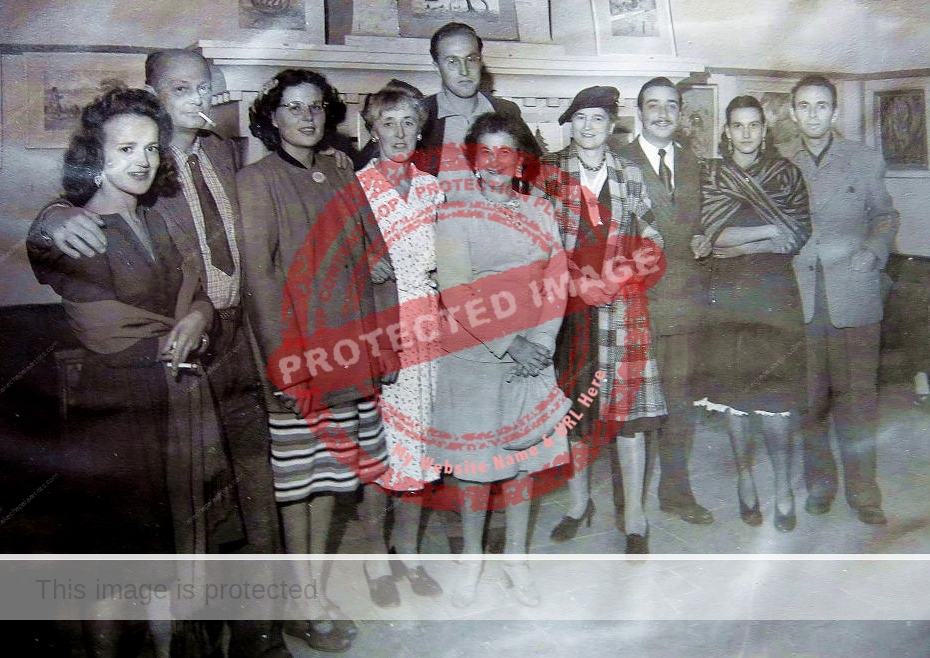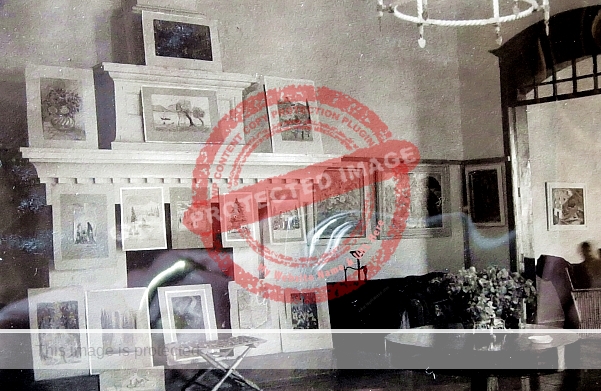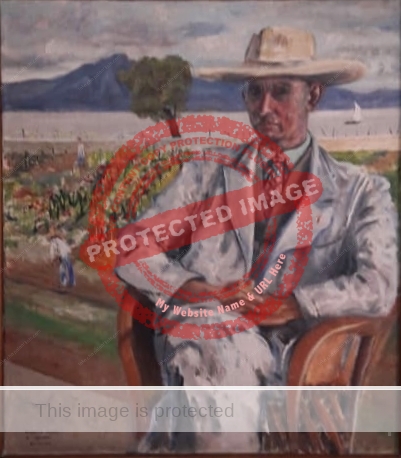The first two art exhibitions of note in the Lake Chapala area were held at the Villa Montecarlo in Chapala in 1944.
The first was a solo show of works by Edythe Wallach in November 1944; a year later, she was exhibiting many of the same paintings in a New York gallery.
The second, a month later, was the area’s earliest documented group art show. And—at least in my view—no subsequent show in the region has ever matched the extraordinary range of artistic talent that was on display in that particular group exhibit.

Artists at the December 1944 art show at Villa Montecarlo, Chapala. From left to right: Sylvia Fein, Otto Butterlin, Betty Binkley, Muriel Lytton-Bernard, Ernesto Butterlin, Ann Medalie, Neill James, Jaime López Bermúdez, Frieda Hauswirth Das (?), Hari Kidd (?). Credit: Sylvia Fein (reproduced with permission).
The show, announced in the Guadalajara daily El Informador as the founding of the Chapala Art Center, opened on 10 December 1944. The ribbon cutting was preceded by a short introductory speech by American poet Witter Bynner, who first visited Chapala in the company of English novelist D H Lawrence in 1923 and later bought a home in the town.
Confusingly, contemporaneous reports name only ten of the eleven artists reportedly displaying their work there. The artists named are Betty Binkley, Ernesto Butterlin, Otto Butterlin, Sylvia Fein, Frieda Hauswirth Das, Hari Kidd, Irma René Koen, Jaime López Bermúdez, Muriel Lytton-Bernard and Ann Medalie. The elusive eleventh artist may have been Edythe Wallach, whose own solo show was a month earlier and who eighteen months later married Hari Kidd.
With the benefit of hindsight it is now apparent that this was a star-studded group of artists. Collectively, they represented a wide variety of countries and varying levels of art education, ranging from the purely self taught to formal instruction in some world-class institutions by world-class artists. Many of the group were young, with few if any prior exhibitions of significance; others had already established their artistic reputation by exhibiting internationally, in major institutions and art galleries.
Their art careers after this Villa Montecarlo show would prove to be equally varied, with some gaining far more success than others. But, taken as whole, this was surely one of the most supremely talented groups ever to hold a joint exhibition at Lake Chapala (or in Guadalajara for that matter).

Artwork at the December 1944 group show, Villa Montecarlo, Chapala. Credit: Sylvia Fein (reproduced with permission).
Betty Binkley (1914-1978) was a precociously talented young artist, born in California, but primarily associated with Santa Fe, New Mexico. Betty was married (briefly) to the very famous Catalan-born sculptor, painter and art educator Urbici Soler i Manonelles. She exhibited widely in the US, as well as in Mexico. In Chapala, she “presented several notable canvases in something of a sub-realistic American style but characteristically her own. Her painting of “Three Children” is particularly delightful and “Her Dogs” (no. 23) has real charm.” She lived the latter part of her life in San Miguel de Allende.
Ernesto Butterlin (1917-1964) was born in Guadalajara to German parents who had relocated to Mexico. Still in his twenties at the time of the Chapala exhibition, his abstract works had already achieved “great success both in Mexico and the United States.” Ernesto lived, painted and taught art in Ajijic for his entire adult life.
Otto Butterlin (1900-1956), born in Germany, and one of Ernesto’s two older brothers, studied art formally in Germany. By 1944 he “was already a well-respected expressionist painter” in Mexico. After living in Mexico City, next door to the studio of Diego Rivera and Frida Kahlo, Otto lived the last twenty years of his life in Ajijic, during which time he held several solo shows at the Galería de Arte Mexicano in Mexico City, taught at the National Academy of Fine Arts, was commissioned to paint in the US and in Haiti, and had a strong positive influence on the next generation of Mexican artists. Otto and Ernesto joined forces to open Ajijic’s first formal art gallery in about 1948.
Sylvia Fein (born 1919), now widely regarded as one of America’s foremost surrealist painters of all time, was preparing for her first solo show. Her paintings in the Chapala show demonstrated “her remarkable drawing skill, execution and expression,” and she has openly loved Mexico ever since. Her works, painted in egg tempera, have been shown in numerous major exhibitions, and are in a class of their own.
Frieda Hauswirth Das (1886-1974), born in Switzerland and best known for an early portrait of Mahatma Gandhi, studied art in Switzerland, the US and France. Her frescoes, portraits and other works won prizes in Paris art shows, and were exhibited in France, the UK, the US, and India. In the Chapala show, her “Cosecha Lagunera” was praised as a “an outstanding work of splendid technique and beauty.”
Hari Kidd (1899-1964) of El Paso, was already well-known for his illustrations of Mexican architecture, folk life and social realism, many of them reproduced in Mexico Magazine. His work can be found in the permanent collections of the Whitney Museum of American Art, the Philadelphia Museum of Art, the Atlanta Art Museum and the Museum of Modern Art in New York. In the Chapala exhibit, Kidd showed “some very interesting floral scenes, a beautiful nude, and a very expressive canvas of two swimmers, all very good examples of his painting skills, and some lovely scenes from Ajijic.”
Irma René Koen (1893-1975) trained at the Art Institute of Chicago, and studied and painted in various art centers in Europe and elsewhere. She traveled the world, from Nepal to North Africa, and exhibited widely. Even as early as the 1920s, she was considered one of America’s leading female artists. After living in Ajijic and exhibiting in Chapala, Koen decided to make Mexico her permanent home. Among the paintings displayed at Villa Montecarlo was her “very impressive rendering of the Paricutín Volcano, apparently taken in the early morning.”
Jaime López Bermúdez (1916-?) trained as an architect but hoped to pursue a career in art. He is best known today for designing and building one of Mexico’s first ‘tiny homes,’ a one bedroom modernist home which could be built for under 1500 dollars. He later owned and ran an art gallery in upscale Coyoacán. A reviewer of the Chapala show wrote that the artist “distinguished himself with several expressive sub-realisms.”
Muriel Lytton-Bernard (1896-1974) was the ‘dark horse’ of the group. Though a reviewer praised her “pleasant and realistic portraits” and “beautifully painted Chapala watercolors,” I have so far learned nothing of significance about her earlier or subsequent art career.
Ann Medalie (1896-1991), born in Latvia, studied briefly in Chicago before working in interior design in California, and then as an assistant on murals in the Maritime Museum in San Francisco, and at the Golden Gate Exposition, where she worked alongside—and became good friends with—Diego Rivera and Frida Kahlo. The paintings she exhibited in Chapala were “immaculate decorative oil flowers.” Several of her paintings of Ajijic, including depictions of the Johnsons’ home (see below) were accepted for national exhibitions in Mexico City. In the 1950s, Medalie moved to Israel, where she was a co-founder of the artist community in Safed.
Edythe Wallach, who may be the eleventh artist in the Chapala show, had held a solo show at the Montecarlo a month earlier. Her work is beautifully executed and very distinctive but she exhibited only rarely. She married Hari Kidd in March 1946.

Otto Butterlin. 1943. Portrait of Herbert Johnson. Image courtesy of Milagros Sendis.
After the closing of the Villa Montecarlo show in Chapala, many of the artists showed their works a few days later at an afternoon exhibition and sale in Ajijic on Wednesday 20 December at the home of Herbert and Georgette Johnson. The sale included embroidery done by village women in a ‘revival’ of a village craft spearheaded by author and village philanthropist Neill James.
The Guadalajara daily El Informador published an invitation (written by Neill James) which listed some of the artistic and literary people then residing in Ajijic, including Zara ‘La Rusa,’ and her mother; Paul ‘Pablo’ Heuer and his sister, Luisa, an author, who jointly ran a rustic lakefront hostelry known as Casa Heuer; visual artists Jaime López Bermúdez, Ernesto Butterlin, Otto Butterlin, Sylvia Fein, Frieda Hauswirth Das, and Irene René Koen; and authors Nigel Millett and Peter Lilley who adopted the joint pen name Dane Chandos to write Village in the Sun, published a few months later.
By 1944 the artistic and literary community in Ajijic and Chapala was clearly thriving!
Sources
- El Informador: 3 Dec 1944, 11; 16 Dec 1944, 16; 19 Dec 1944; 24 Jan 1947, 6.
Comments, corrections and additional material are welcome, whether via the comments feature or email.
Tony Burton’s books include “Lake Chapala: A Postcard History” (2022), “Foreign Footprints in Ajijic” (2022), “If Walls Could Talk: Chapala’s historic buildings and their former occupants” (2020), (available in translation as “Si Las Paredes Hablaran”), “Mexican Kaleidoscope” (2016), and “Lake Chapala Through the Ages” (2008).
Nice-nice collection of artists esp. during WW II years–
Bill, Thanks! And Happy New Year! Best, TB.